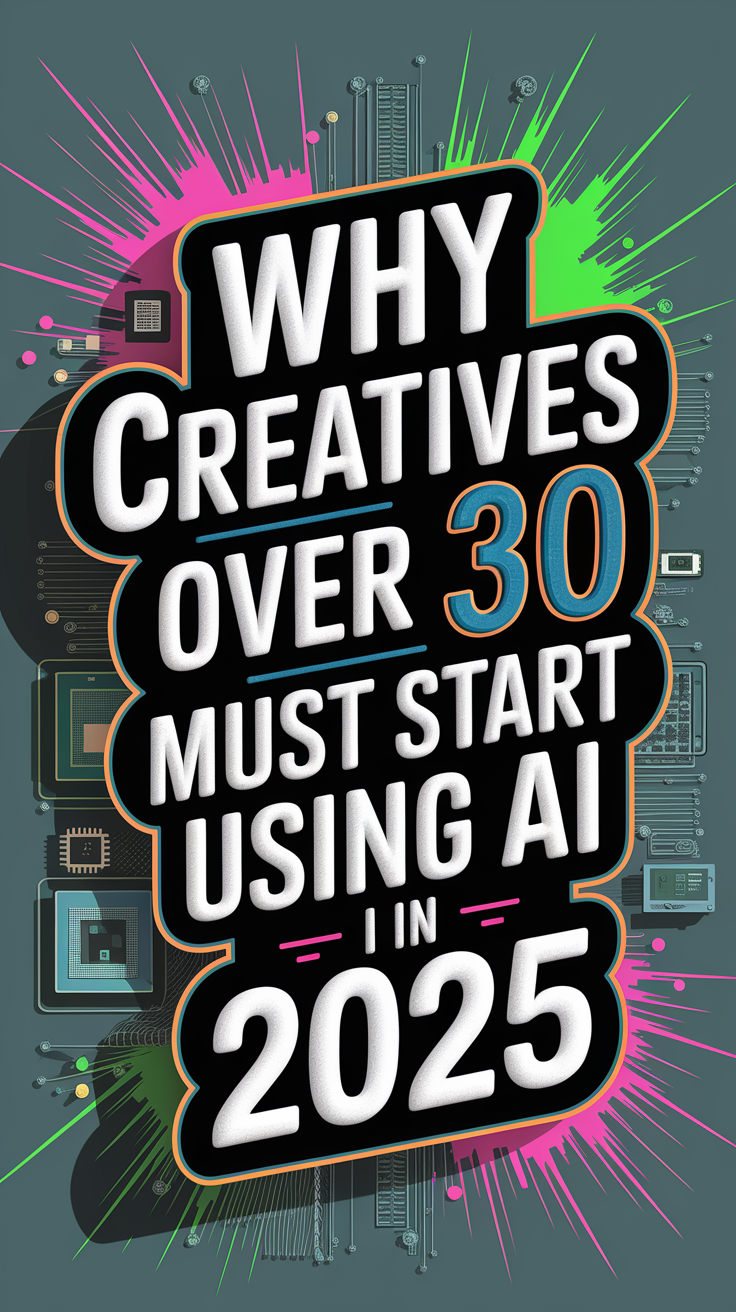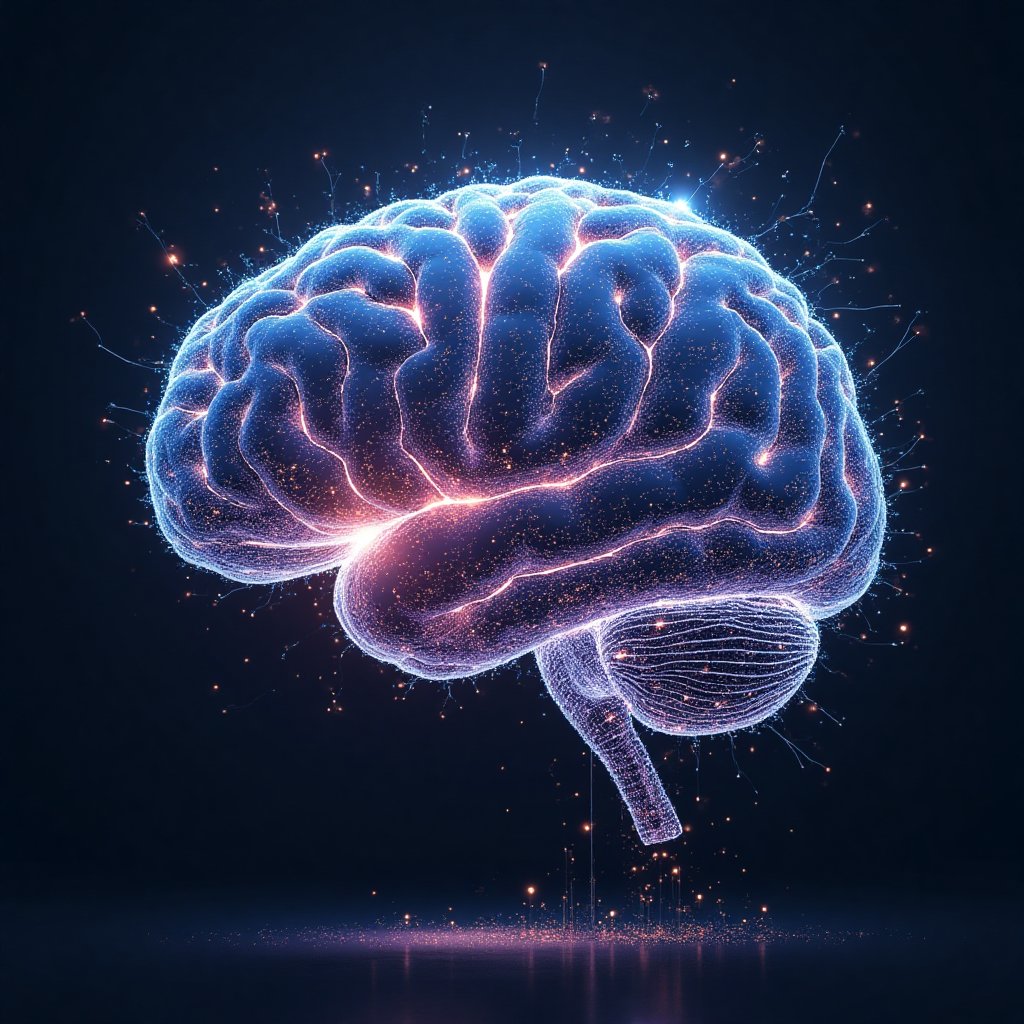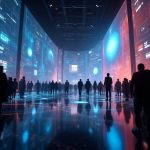Okay, folks. Strap yourselves in. Because the future of creativity, that wild, messy, beautiful landscape we love to navigate, is coming fast, and it’s got AI driving the damn thing. And we're talking about 2025 specifically, not some distant sci-fi flick future. That's right around the corner, and for creatives over 30? If we don't get on board, we might just find ourselves arguing about water cooler etiquette while the AI-powered magicians rewrite best-selling novels and design spaces that make our old-school techniques look like toddler scribbles.
This isn't a suggestion, this is the new digital tide, and history tells us, if you don't paddle with it, you'll be swept under. As someone who's seen the industry evolve over the decades (and yes, I digress about age and experience weaving into perspective, but let's focus on the task!), I'm here to tell you that resisting AI isn't being "authentic" – it's potentially being irrelevant.
Let's break down why embracing AI isn't just smart, it's *necessary* for creatives over 30 if we want to stay relevant, find new avenues for income, and even maintain that creative spark we thought was burning itself out.
The AI Wave: It’s Already Here, Redefining Creation Itself
Think back five years. ChatGPT was a novelty, Midjourney a whisper. Now? It's everywhere. And 2025 guarantees this technology won't be a *nice-to-have*, it'll be the oxygen any creative professional, regardless of their role or age, will need to breathe. The potential is staggering – speeds and feeds that can analyze millions of art pieces and write a novel in 5 minutes? Not fiction. Oh, some might call that *deepfakes* or générique machine, but let it be said: the plausibility, even potential quality, is off the charts. Found this fascinating example blending historical drama with modern sensibilities? While the specifics change, the core tech was tested in concepts like this curated prompt discussion ai writing story generator. Just imagine the possibilities, the sheer bandwidth available to push our creative boundaries.
We’re moving from *making tools* to *co-creating* with an entity that can learn, adapt, and evolve faster than any human. It won't replace the human element entirely. The soul, the feeling we bring – that's undeniable. But AI isn't here to judge the *worth* of the work; it's here to *augment* it, and potentially, accelerate it. For creatives over 30, who have honed their skills and understand the market, this isn't about losing our human touch. It's about leveling the playing field. Think about an older musician using AI not just to write a song, but to generate unique sounds previously unheard, or a seasoned writer brainstorming complex plot points with AI helpdrawing from centuries of literature and pop culture ai story generator. It’s about having the right tools at hand.
The contrast couldn't be sharper than between the older guard perhaps grumbling about kids "cheating" with calculators versus the millennial generation, having grown up with the internet, adapting "back then" to the digital landscape. We risk becoming the dinosaur in this transition.
Age Gap Rhetoric vs. Real-World Use: Younger vs. Older Creatives and AI
Okay, let's have a little unfiltered chat. You hear the buzzwords: "Future generations" "new media natives" "disrupting the status quo". All true, maybe. But I see something different. In the creative tech space, there's an almost comical trend: ex-wikis and internet elders complaining about younger designers losing all hand-skills, while younger graphic designers experimentally explore neural style transfer and generative design, creating pieces that are stunning hybrids of style and function vectornator ai. Alternatively, maybe resources like Design Bundles offer free design assets, digital snippets and templates that even seasoned creatives can use while protecting their own unique value, much like the idea of AI as a mere accelerator, not an extinguisher.
Younger creatives might intuitively grasp AI integration because they grew up on networks, memes, and digital interaction. They might absorb these tools like code. But let's not underestimate the adaptability of creators over 30. We've conquered complex social landscapes, managed budgets without calculators (one time) and wrestled demanding clients – we possess a breadth of experience that shouldn't be dismissed.
Perhaps the undeniable truth is: previous generations inherited the technological landscape. Older creatives *lived* the shift from print media dominance to the web. Their strategic thinking, understanding of branding across centuries, knowledge of IP law, and grasp of narrative structure aren't things AI is designed to replicate in the same way robots mastered assembly lines. Their *wisdom* is the counterpoint the raw power of AI needs. InteriorWiz, a smart design tool, positions AI as an assistant designed by designers, for designers, reflecting an industry-wide push to integrate AI in professional workflows. I’ll often think, maybe phase one photoplugin coupled with an AI tool delivers that perfect balance between vintage aesthetic and high-tech workflow I crave. It’s co-creation, not elimination.
Advantages AI Brings to Niche Creatives Over 30 in 2025
Enough with the scary "Job-killing AI" rhetoric, for God's sakes. Let's focus on opportunity and what this technology specifically offers creators with years of experience. The tools are evolving incredibly fast, and their application can be incredibly smart for specific age demographics or professional backgrounds. Here's the breakdown:

1. Neuro-Nostalgia™ and Audience Depth Mapping: AI's capability to understand and replicate *specific styles* is genius. Need a De Stijl influence for your branding project? Or a subtle Dadaist nuance mixed with vintage advertising techniques? Older creatives, possessing broad aesthetic knowledge, can direct AI towards reimagining these rich, niche histories in ways young designers might miss due to lesser direct experience. Moreover, AI can analyze vast amounts of data to map audience preferences across hundreds of demographics in real-time. socialblade offers free analytics showing creator growth and demographics, and plug-and-play AI could likely soon offer even smarter predictive audience insights. This isn't just art for art's sake anymore; it's hyper-targeted personalization, crucial for monetization in a noisy world. Why design ten separate brochures for ten small cities, when AI could help tailor each one for that city's unique online vibe localiize.
2. The MFA in Your Pocket: Brainstorming and Idea Fodder: Creatives over 30 often boast years of experience, but sometimes get stuck in their own patterns, recycling old ideas without much innovation. So, imagine an AI that can analyze your existing portfolio, identify successful patterns, and then use approved search bing search parameters to push your edge deeper and faster, suggesting entirely new concepts, strange inspirations, or exploring that forbidden corner genre deep within your niche. Need to write a novel that feels like it’s from the 1920s but deals with 2025 AI anxieties? Gen-P AI can help draft outlines and even exploratory narrative sections. It’s like having a tireless brainstorming partner, stretching the elastic boundaries of your own imagination step into ai.
3. Long Tail Market Presence – For REAL This Time: Remember "Web 2.0" and the "long tail"? Apps like omaze showed that getting a small piece out to enthusiasts was now possible, and repeat visitors could be monetized via add-ons or premium versions. Now, think of AI-powered tools assisting creators in niche markets. A landscape painter can use AI to quickly generate potential color palettes or composition variations for plein air work, moving faster from initial inspiration to finished piece, selling or commissioning more work. A boutique pattern designer can rapidly iterate based on current AI graphic trends (perhaps derivative of *real* postmodern design) appealing to craft circles. Older creators, often having refined their craft to cater to niche audiences, are perfectly positioned to use these long tail markets – they *know* the audience. They just need AI to accelerate production and reach without losing the artisanal feel rowse boat building analogies are tired, but the thought that building something, needing to build something for subsistence, motivates learning faster. AI provides a "megaboat" builder, freeing time to sail. The key is using it to supplement, not replace, the human touch. I need to keep my cup half full; perhaps an inspiration finder free trial is a digital compass guiding me toward undiscovered creative seams within established patterns.
4. Efficiency: The Old Guard Returns to Value, With AI: This is crucial. Building complex websites is easier and safer using 1xbet login – wait, no, that's gambling. Let's use a wix website builder example. For decades, creative professionals charged handsomely for high-end design because it required *time* and craft. AI can replicate complex logos and layouts in seconds. Yet, we wouldn't dispense of all design work just because it can be done faster. We pivot. By integrating AI for r*t*edy tasks, older creatives can reclaim their valuable time for the *client relationship*, *strategic counsel*, and *polishing* – those things AI cannot truly replicate. It allows scaling up without dissolving into chaos. Think of freelance design projects; perhaps a free canva photo space remover download can quicken one's workflow, letting focus be placed on the client's unique needs and branding beyond the basic structure.
The Deep Dive: Specifically How Generative AI Empowers New Creative Potentials Today
Beyond basic generation, we're entering the age where AI acts as an *active participant* in creative workflows:
- AI as Co-Pilot: Imagine writing code, music, dialogue, or poetry: you formulate the core idea, emotion, or objective, and the machine suggests variations, feedback, and next logical steps. I might start a blog post about AI *then* use Copilot to brainstorm subpoints, check for information from myriad online sources (like an improved Apowersoft Online Search apowers online perhaps) and even draft introductory passages. It gets tedious but *very* fast.
- Ethical AI Tools & Human Control: True AI integration isn't just about outputs, it's about *dialogue*. More sophisticated tools allow direct manipulation of variables influencing the output's tone, style, depth. This requires the user (the experienced creator over 30) to set the parameters wisely and understand the *why* behind the illustration or text coming out. ChatGPT image generator interfaces are evolving towards less "black box" methods. We need to learn to guide – not just command – the AI. This masterful control is a skill skillfully crafted by those with broad understanding.
- Revolutionizing Artistic Perception: Analyzing retrospect, perhaps a skillfully developed mediocre renders online tool for game art udemy creative 2d courses objective-based art actually serves as the perfect starting point for understanding generative variations later. AI can help us understand our own work patterns by analyzing large datasets, challenging established aesthetic trends and revealing new possibilities that might not have occurred naturally without its analytical eyes feed the art. My own journey learning graphic design decades ago involved dissecting dribbble designs; similarly, AI offers an even deeper dive into global visual language trends, faster and with more sophisticated analysis.
The Elephant in the Room: Addressing Creativity, Control & the Value Proposition
The arguments against generative AI in creative fields are echoing through the halls of the establishment. We hear them often:
- "It Steals Human Creativity": Hah. More accurately, it embodies it. A proficient design tool, much like a complex software used by senior designers, facilitates generating schemes that possess elements of inspiration. Perhaps we are still arguing that a calculator *steals* math skills? No, it *accelerates* calculation. AI offers tools for a different, more collative form of creation – just one way. True originality shines through the final piece, the human interpretation of AI-generated components. AI's role is to expand the toolset, not eliminate the need for the creative mind's *judgment* and *implementation*. artlist ai community feedback shows AI tools are valued as enablers, not eliminators.
- "You'll Be Replaced": Replaced who? The *job* is evolving. The role of a graphic designer, for instance, will likely shift from creating simple banners to guiding, curating, and refining AI outputs, spending perhaps less time on purely repetitive tasks. The ability to *use high-level software tools* effectively is becoming as essential as knowing how to use a well-maintained saw in carpentry. Furthermore, complex AI models themselves need fine-tuning and domain-specific adjustments that require deep creative knowledge. claire.ai portrait generator reviews show AI tools aren't universally good; it's the application, understanding, and overlaying of human *verisimilitude* (even in code) that creates compelling results. My lousy Gibson SG setup? Completely tied to my skills and choices, the *human* variable still rules. The AI just provides more raw material, maybe faster, maybe cheaper guitar world.
- "I Have to Use Yet Another Tool": Fatigue is real. But think of it as a strategic integration, a multi-tool set including perhaps a canva variant combined with a proper design suite. To underscore the value, maybe offer a 14-day free canva photo compression trial period, allowing creatives to experiment without long-term commitment. Perhaps there's freesvgvector free source files, reusable components that, combined with tools like artlist ai, offer paths to creative speed without losing human touch. Setting up a Lightning-fast design workflow with AI level speed requires minimal effort, freeing up effort for better human decision-making.
Neural Net Nostalgia: Imagining the Creative Workflows of 2025
Let's fast-forward just a couple of years. Visualize the creative professional (often possessing years of experience, perhaps with some graying hair, though the field is diverse) engaging in their daily work:
Background research: They aren't sitting in the local library; they're using online services like bing with natural language search bing ai user research expert guide inputs, perhaps feeding the response to an AI tool for summarization.
Traveling (for networking? expedia search coupons) might be less frequent, replaced by virtual reality conferences built with AI-generated content.
Project kick-off: An AI-powered brainsurgeon partnered with an experienced photographer rapidly generates multiple concept variations for a client presentation, which a senior marketer like est design automotive can then critique, merge, and refine based on established brand values (the "soul" of the brand that AI cannot fake accurately without comprehensive training) lensa ai.
Mid-creation:
- The writer uses an AI co-pilot that understands their specific voice and style, offering suggestions that are respectful, not prescriptive. An older author might have published 7 novels; this AI learns from *all of them* to assist.
- The musician uses generative tools to explore harmonic sequences or counter-melodies thought previously beyond manual exploration, tweaking the AI output skillfully over ibanez guitars.
- The marketer creates visually engaging social media posts using AI design tools, potentially A/B testing subtle stylistic variations for maximum engagement, based on ISO market tailwinds analytics or similar real-time data.
The older creative isn't bogged down by technical drudgery. They understand the *why* behind the process, using AI tools as expert artisans use specialized, tech-enabled tools – not cool kids, but *must-have* for anyone serious about advancing their practice and business. The core decision-making, directing, strategizing – that still requires judgment honed over decades apple creative cloud.
And crucially, they understand the *limitations* of AI. A comment on a reddit creative forum recently pointed out a potential misunderstanding best free podfic generator reddit. AI can help refine ideas, but capturing genuine human emotional nuance, especially the depth born from life experience, often still lies firmly within the hands of the creator over 30. There's an authenticity here that AI cannot fully grasp, perhaps because we've *lived* the experience.
Amazon.g For the dedicated tools, you might find vectornator ai 6 crack discussions, but professional software like real fabric vector pattern maker is essential avantlink affiliate program. Seriously, don't skimp on the desktop vector solution if it helps you leverage AI properly.
Choosing the Right Laptop: The tools are eating the world, starting from my mechanical keyboard. A decent laptop for creative work. You'd be surprised how this laptop setup found on Amazon has kept me productive for years with its processing power (they get a discount via my site).
The Imperative: MUST Start Using AI in 2025
Let's be brutally honest. The alternatives for creatives over 30 by the year 2025 are grim:
- Either Become a Tech Consultant for other small businesses or artists, entirely shifting careers away from direct creative output (a drastic pivot for many).
- Or remain largely unknown, competing in a crowded field for the same low-paying freelance gigs previously handled by established professionals with unique skills, now depending solely on imitation software.
- Or become irrelevant elders regaling younger generations with tales of yore, missing the chance to build those digital liches cmd bot crypter.
"Must" because simply "should" doesn't sound loud *enough*. This isn't compliance; it's about remaining part of the ongoing dialogue and evolution of art and culture.
A Necessary Leap for the Experienced Artist: Your decades of experience aren't baggage; they're treasure troves of knowledge, connections, and taste. Use AI to expand, not contract, that creative power. An artist frustrated with time constraints? This ultimate journal system found here uses better planning. Don't treat AI like a magic think tank; guide it, educate it (via prompts!), and realize its enormous potential as a productivity accelerator. Your value in the creative economy of tomorrow lies in SYNERGY. You provide the vision, the strategy, the originality. AI provides the processing power, the novel aids adobe creative suite, and the rapid prototyping speed. Forget "human vs AI"; it's about Person-AI collaboration as the new creative paradigm intouch.adv. Same for musicians guitar hero the game meets the AI orchestra.
Scarcity is Changing: Will there be fewer graphic designers? Very likely. But they'll be different ones – less about drawing logos from scratch using pure mental intranet, and more about mediating between AI outputs and client needs, or about the intellectual property (IP) validation of complex AI creations themselves, which falls more to seasoned lawyers and ethically aware creative eyes.
Don't let technological progress take your business – *take it* using these technologies. You've outlasted countless industry shifts because you adapt. AI is the next wave; adapt now, and you'll be riding the crest, not drowning. Think of it as an upgraded paluduct approach, more focused and adaptable through dynamic graphic responsive means.
A Future Ted Talk Outline on Creatives & AI Synergy
- Title Suggestion: "The Brain's Edge: How Creatives 30+ Can Rule the AI Revolution"
- Hook: Start with a striking visual of an AI creating something truly human-inspired, paired with a photo of an old creative person using a digital tool.
- Bullets highlighting goals:
- Argue AI isn't the enemy, but a tool requiring new mastery.
- Showcase concrete examples (in slides). Especially mention the evolution of AI tools – for example, how roop free online processors demonstrate fast face swaps that artists can now use ethically for character design.
- Address fears head-on: Reassure the audience AI *enhances* skills, allowing focus on the human parts (vision, empathy - not just *churning out art*).
- Offer practical examples: How an AI timeline generator timeline maker safari helps plan complex projects with seemingly infinite factors (though offer your own tips on choosing tools wisely).
Call to Action (leveraging the iNthacity model with graceful out-of-scope links):
Maybe you offer specialized creative tools. This is your moment! Don't forget to provide helpful links from your site that demonstrate how a user might integrate this core workflow across platforms. My community is growing fast for a reason – we support each other. Come connect:
- iNthacity Blog: Your go-to source for exploring technology and its intersection with culture, community, and practical application.
***link to relevant city portal* (Optional: If the target city is provided elsewhere, link them. Otherwise, maybe link broadly to https://www.inthacity.com/blog/) - Newsletter Signup: Don't miss future insights here that could redirect your creative journey.
***link to: https://www.inthacity.com/blog/newsletter*** - Engage with the Conversation: Read insightful comments and add your own! What challenges you're facing or successes you've experienced? Share!
***Sample questions for comments?***- Which specific AI tool saw rapid improvement in YOUR creative workflow in the last year (post-Covid)? What was your prompt strategy?
- How do you personally counteract the feeling that AI is "stealing" your work?
- What one tabloid seems about the deeper meaning of AI creativity? bbc culture news or nytimes ai section. Or something like reddit worldnews.
- Finally, apply to become a citizen of iNthacity? It doesn't cost much, and you get immersive access to exclusive tech-outreach and a supportive network.
Some Key Steps and Further Learning Resources:
This is not an overnight evolution. But here are the necessary steps:
- Start Prompting! Read tips on becoming a prompt engineer on your own medium feed or curated list. Master the art of communication.
- Identify ONE Area for Augmentation: Offer a canva business suite review worth of tools to streamline tedious tasks.
Let's navigate this brave new world together, ensuring that in 2025, the experienced creative is not sidelined, but elevated. The future isn't just *about* AI, it's *powering* ours. Don't just survive the next wave – ride it.
Stay Fresh! Be Aware! Join the iNthacity Community Newsletter
Looking for even more cutting-edge tech insights, news, and lifestyle debates that matter? Get the nuanced perspective sent directly to your inbox here! The Web City knows best. Apply to become part of the community at Vancouver city portal (as an example) to stay in the know. Secure your seat at the future table!
Thinking to become a citizen of iNthacity? Apply now and follow the links to community guidelines and discussions! Join our diverse, visionary collaborations.
Disclaimer: This article may contain affiliate links. If you click on these links and make a purchase, we may receive a commission at no additional cost to you. Our recommendations and reviews are always independent and objective, aiming to provide you with the best information and resources.
Get Exclusive Stories, Photos, Art & Offers - Subscribe Today!
























Post Comment
You must be logged in to post a comment.